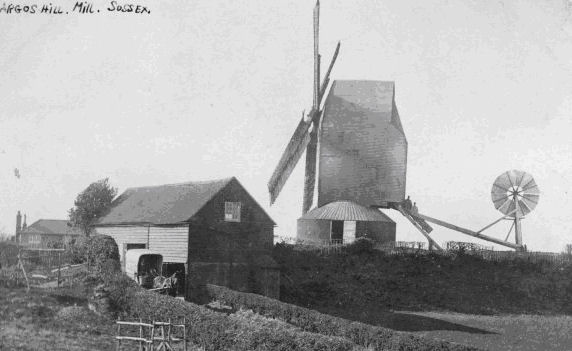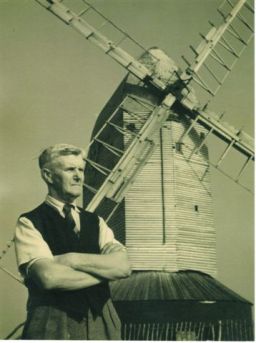Millers
In the 1720's the mill and 32 acres of land are recorded as in the tenure of Francis Hammond, and a little later Benjamin Siggs. The family most associated with milling in this area was the Weston family who worked the mill on Argos Hill for at least 75 years up to 1912.
Aaron Weston, born in 1799, worked at Merryweathers water mill until his uncle, John Weston, died. At that point Merryweathers was sold and Aaron moved to Argos Hill to work with Thomas Dann who had lived at Mill House and been the miller since 1785. In 1822 Aaron married Eliza Dunn and took over the mill and Mill House after her father's death. They eventually had nine children, six boys and three girls.

It is assumed that the post mill that we know today was built for Aaron. The cast iron wind shaft and the workings of the mill date from this time. In its day, the mill was more efficient than other local mills and certainly ground a better quality and a more even flour. Post Mills were the most expensive type of windmill to be built and they were considered to produce a superior result.
Tithe maps of Mayfield following the Tithe Commutation Act in 1837 show that Aaron Weston was the owner of the mill and the area now known as Mill House. At the time of the 1851 census, Aaron gives his occupation as miller and farmer. Two of his sons were also millers, and a farm labourer was also employed and lived in the house with the family.
The Sussex advertiser dated March 19th 1861 printed details of a sale by auction the following day, by directors of the executors of the late Mr Aaron Weston. The sale included cows, a horse, a cart, a millers van, farm implements, a corn winnowing machine, scales, beam and weights, and also household effects.
Aaron's second son, also called Aaron Weston, succeeded his father as miller at Argos Hill. The 1881 census shows him to be aged 57 and gives his occupation as Master Miller. He married Frances nee Hicks, but they were childless. The census shows that he employed two assistant millers.
Aaron died aged 63 on January 16th 1888 and is buried in the churchyard of St Dunstan's church in Mayfield. His gravestone is impressive. He is said to have left £10,000 to his widow, a sum worth approximately £600,000 today. This enormous sum sounds improbable and it has not been possible to confirm it, though a Document dated 1865 is evidence of Aaron selling land with a reference to a reputed £10,000 estate.
celine 73306 trendy sunglasses here was aaa quality well cloned.rolex swiss YRCX Disposable Vape has long been passionate about watchmaking talent.

Aaron's eldest nephew, Raymond Weston, was the next miller. The census of 1891 lists him as miller and farmer at Mill House. He was married to Ann nee Weston, and he remained as miller until 1912.
George Wickens bought the mill in 1912 and worked it commercially until 1923. It remained idle for the next two years, and it was said to have ceased to work commercially at this time. However, we have three accounts of it being worked in the 1930s. Corn was brought to Argos Hill by horse and wagon from as far away as Huggates (Furnace) Farm, cutting across Stone Farm and Pages Farm, then up Red Lane and Windmill Hill to the mill.
There are several reasons why windmills declined at around this time. There were in any case many mills in the area. For convenience, when farmers used horse and wagon to deliver wheat to be ground and to collect the flour afterwards, a short distance was an obvious advantage. The gradual arrival of motor transport enabled the farmers to use the bigger power driven mills further afield. Some farmers preferred to grind their grain on their farms when small internal combustion engines were available. These could grind good quality flour quite economically. So millers found less work, and they had increased expenses as wages grew, and as ever there were lost days when there was no wind. So windmills gradually became redundant.

Photograph taken about 1930.


